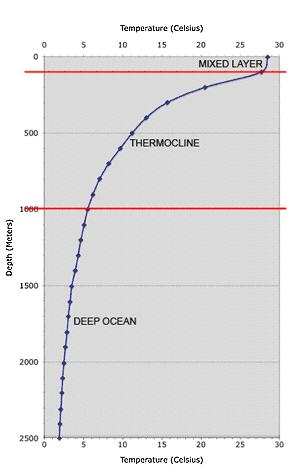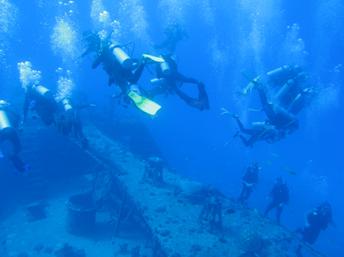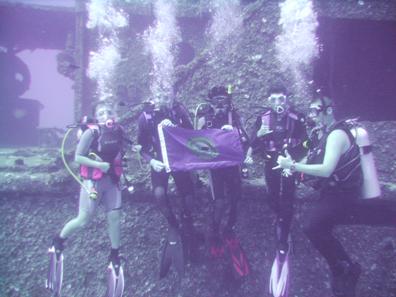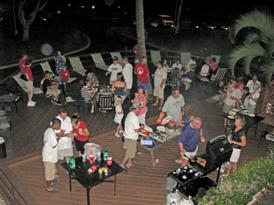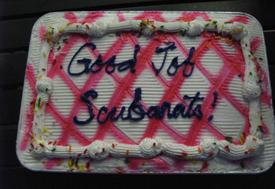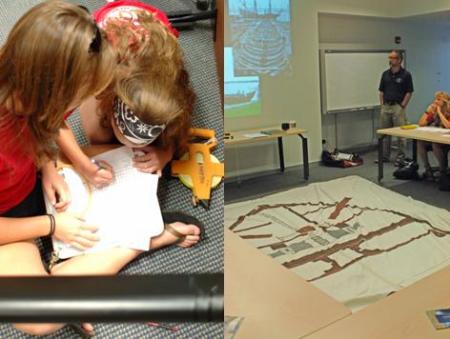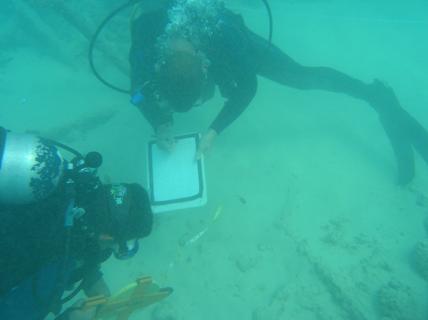What an exciting dive!
The students made several interesting observations.
First, it was very dark by the time the submersibles made it to the sea floor, at about 400 meters. Life that depends on photosynthesis cannot exist below about 200 m underwater. (Remember when the students climbed, less air was exposing them to more ultraviolet light! Heights and depths make a big difference!)
Second, the submarine in the picture looks “like new.” “Why?” I wondered. I had read that sunken ships were often the home to coral reefs. A look on the Web indicates that most corals need sunlight to live, because the algae in the corals need sunlight for photosynthesis. The submarine, at 400 meters below the surface, is in the darkness, so corals can’t grow.
Third, there is still life there in the dark oceans. Some of the life we see at the surface. Sperm whales can dive 500 to 1000 meters below the surface to get food. Some animals in the dark depths feed off raining organic matter from above. Or they feed on animals that swam down from higher up.
And some life finds the energy needed to survive at the deepest ocean depths. FLEXE scientists are studying life in much deeper waters. This life depends on nutrients and a chemical source of energy that seep out of cracks in the ocean bottom, rather than the energy found in sunlight. You can learn more about FLEXE and monitor a FLEXE Research Cruise and a Teacher’s Blog of the cruise through these links.
Fourth, the divers have to go to 400 m in a submersible because of the enormous pressures at these depths. Remember that about 10 meters of water is equivalent to one atmosphere of pressure? At 400 m, weight of the water is around 40 atmospheres, so the total pressure is 41 x atmospheric pressure, counting the weight of the air as well as the water.
Day 12 - 22 October 2007
Location: Waters off Honolulu, Hawaii
Event: Deep Sea Exploration in Pisces IV and V Submersibles
Collin (Pisces V)
Anna and I arrived at the Hawaii Undersea Research Lab (HURL) vessel, Ka’imikai-O-Kanaloa (KOK), at seven o’clock Monday morning. We were brought to the vessel by my Uncle Ed Scheiffer since we stayed at his house last night. It was a beautiful morning with blue skies and calm waters typical of each day we have been in Hawaii so far. As Anna and I boarded the KOK, Terry Kerby and crew were busy preparing the ship and submersibles for departure so we were rushed to board and stow our gear.
I was extremely excited for this mission because I was finally doing it. After all the preparation and training, I was finally going to descend in a manned submersible to a great depth. It was something I never imagined I would be doing, especially at my age. Maybe it was because I was nervous, but it seemed that immediately after we boarded, the KOK left the dock and made for our destination.
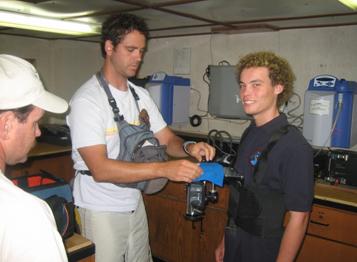
Breakfast on the ship was great. They had a little of everything. But I was a bit nervous and wasn’t able to eat much. I was still thinking that there wouldn’t be a bathroom in the submersible so I didn’t want to eat or drink much. Although somewhat rushed, it was a great start to the day. On the way out, we had a fire drill which I was told was standard practice.
It wasn’t long before we reached our ship’s destination and began to prepare for the launching of the submersibles. I was to be the first in the water. When we received the OK, I began to make my way to the Pisces V (Anna was in Pisces IV), which was the submersible I would dive in. Then I made my way up the ladder and boarded through the hatch on top of the submersible. Once inside, the computer consoles and everything was lit up and it looked and felt as if I was in a space shuttle preparing for lift off and moving into a place where not many have ever gone before. I was overwhelmingly excited while we were lifted by a massive winch from the mother ship (KOK) and placed in the ocean. By the time I felt we were detached from the boat and we were on our own, I could feel the adrenaline pumping through my body.
While we were on the surface, Terry Kerby, the submersible pilot, conducted a systems check and we then started on our way to the depths of the ocean. As we descended deeper and deeper, the color of the ocean around us became darker and darker as we strayed from the sunlight. When we reached bottom, at about 1300 feet (about 400 m), it looked like something you would see on the sci-fi (science-fiction) channel. I observed orange fish that walk on the bottom, and corals that some of us have never even seen before. I can’t even describe how splendid it felt to be sitting in a submersible 1300 feet below the surface looking out into a world hidden in darkness. Everything looked amazing and peaceful on the bottom.
I was overwhelmed with awe all the way through the seven hour dive in the cramped sphere. It was difficult to move about, so the best position was to simply lie down. When we started our descent we already knew we were in the vicinity of the Japanese Midget sub that was sunk in WWII. We found the exact location by using sonar. Using the sonar, I was able to pick up shapes and objects great distances away from the sub. After about a half an hour of searching, we came across the midget sub and honed in. Suddenly, the stern side of the midget sub was staring straight at us. We had found it! I was overwhelmed at the sight. Looking at such a historical submarine that people rarely ever get a chance to see in all their life was fantastic. The sub appeared to be in great shape, exactly as it was when it was seen last.
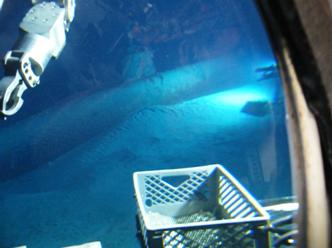
After we were finished viewing the midget sub, we decided to move south and explore ocean that Terry Kerby has not yet seen. As we were moving south, our depth was increasing and the feeling in the sub was tense. We had no idea what to expect. Once, unexpectedly, a deep sea shark actually came up from under the sub and swam by the porthole. Other forms of life that we saw were different corals living on rock piles and fish we had not seen before. We also used the robotic arm to pick up two mugs and a Coca-Cola bottle from years ago. We made a final depth of about 1800 feet, and then we got the go ahead to rise from the depths. So, with that call we released the weights, and started to ascend. Once we were on the surface I felt that I accomplished something very special and that I enjoyed every part of the dive, but after seven hours in a tight space it felt good to climb out of the sub and walk.
Now that I am once again back on the ship and the submersible is secured, I have had an opportunity to reflect on this great and wonderful lifetime experience and what I have learned from it. One thing is for sure, that I have a deeper appreciation and respect for these scientists and submersible pilots and the work that they do. I also have a greater appreciation for the risks that famous explorers had undertaken before me. And I believe that I felt very much like they did at one time when we maneuvered Pisces V to discover ocean bottom that has not yet been seen by human eyes. It is an exhilarating experience and accomplishment.
Anna (Pisces IV)
I am glad that Collin went first, because I was able to watch Pisces V enter the water. First the three of them entered the sub which was then closed and the chase boat was deployed. Second, the giant wench placed the sub in the water and a man jumped from the chase boat to the top of the sub to disconnect it from the “mother ship.” Then Pisces V started to “dive, dive, dive.”
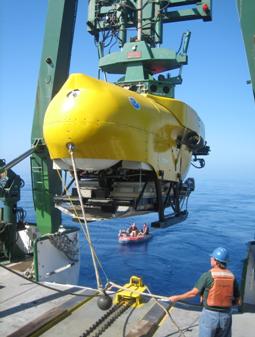
Then the Pisces IV was moved forward in preparation for the entry. Someone that worked on the boat came over and told me that I was the youngest person to go into the submersibles (Collin is older than me). Usually the youngest are grad students. Then I was told to climb the ladder and at the top I had to unfurl the Explorer’s Club Flag, I was so afraid of dropping it in the cool breeze.
Then I went down onto the submersible and Max and Bryan were also in, then our entry began. The sub was closed at 10:26am; we didn’t enter the water till 10:33am. 10:38 we began to sink and we reached the bottom at 10:55am. The sea floor was pretty and mostly sand and few rocks. Right away I was amazed to see this snake, eel type thing that was probably between 1 and 2 feet long. I also saw a few other types of eels, starfish, hermit crabs, shrimp, puffer fish, an octopus, and some small fish.
With the help of the mother ship and Terry Kerby we finally found the Japanese midget sub at 11:40am, the depth was 406.04 meters. At 3:00pm we were cleared to ascend and surfaced at 3:28pm. By 3:36pm the mother ship began to pull us in and I was standing on deck at 3:40pm.
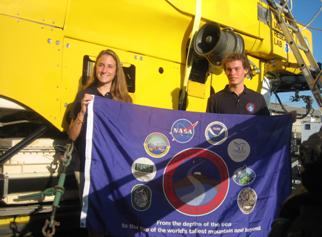
Well my Hawaiian trip is ending, but I have made some of the greatest achievements of my life on this trip. I know I will never forget this. I am so thankful that I was chosen to represent not only SCUBAnauts, but my generation of youth explorers. This trip has, without a doubt, changed my life. I have a new confidence of the others that climbed the mountain with me and a new confidence in myself. This may affect my career because before this I had never considered exploration, research, marine sciences or even the military field.
On my last day with Mark Fowler he said, “You need to work through the valleys to make it to the peaks.” I think that this quote perfect to represent this trip. We worked through the valleys in preparing physically and mentally, also through some of the problems like the boat’s leaks. The “peaks” of this trip are pretty obvious.
